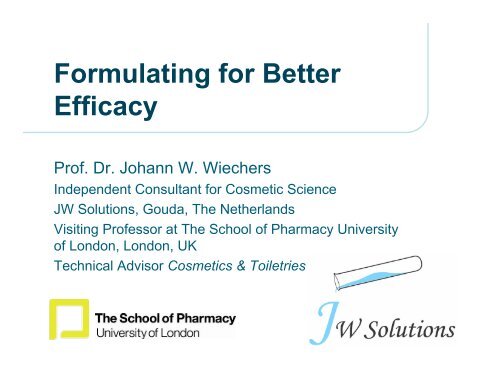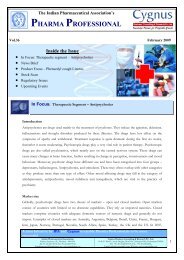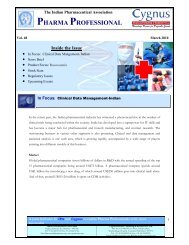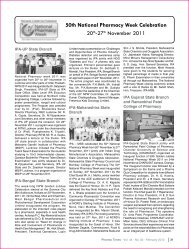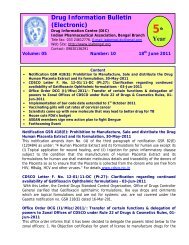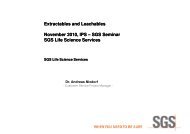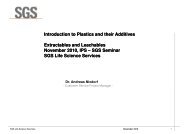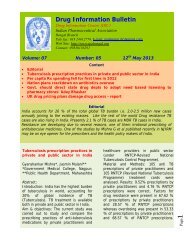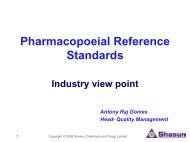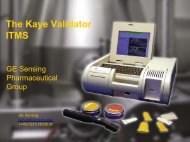Formulating for Better Efficacy
Formulating for Better Efficacy
Formulating for Better Efficacy
You also want an ePaper? Increase the reach of your titles
YUMPU automatically turns print PDFs into web optimized ePapers that Google loves.
<strong>Formulating</strong> <strong>for</strong> <strong>Better</strong><br />
<strong>Efficacy</strong><br />
Prof. Dr. Johann W. Wiechers<br />
Independent Consultant <strong>for</strong> Cosmetic Science<br />
JW Solutions, Gouda, The Netherlands<br />
Visiting Professor at The School of Pharmacy University<br />
of London, London, UK<br />
Technical Advisor Cosmetics & Toiletries
The answer to better efficacy is simple,<br />
don’t you think?<br />
2
The answer to better efficacy is simple,<br />
don’t you think?<br />
3
Can technology provide better answers<br />
in financially challenging times?<br />
4
“<strong>Formulating</strong> <strong>for</strong> <strong>Better</strong> <strong>Efficacy</strong>” is a<br />
structured approach to <strong>for</strong>mulation<br />
design<br />
1. Selection of the drug / active ingredient<br />
2. Selection of the emollient<br />
3. Selection of the emulsifier<br />
4. Selection of adjuvants<br />
5
“<strong>Formulating</strong> <strong>for</strong> <strong>Better</strong> <strong>Efficacy</strong>” is a<br />
structured approach to <strong>for</strong>mulation<br />
design<br />
1. Selection of the drug / active ingredient<br />
2. Selection of the emollient<br />
3. Selection of the emulsifier<br />
4. Selection of adjuvants<br />
6
Step 1: Can my drug / active penetrate<br />
the skin in sufficient amounts?<br />
Select only drugs/ actives that:<br />
- MW < 1000, ideally
Step 1: Can my drug / active penetrate<br />
the skin in sufficient amounts?<br />
Calculate the permeability coefficient using the<br />
Potts – Guy equation:<br />
log k p (cm/sec) =<br />
- 6.3 + 0.71·log K oct/water - 0.0061·MW<br />
Potts, R.O., and Guy, R.H., Predicting skin permeability, Pharm. Res. 9<br />
(1992) 663-669<br />
8
Step 1: Can my drug / active penetrate<br />
the skin in sufficient amounts?<br />
Input = J ss<br />
= k p · ΔC<br />
Output = Cl · C T<br />
C<br />
T<br />
=<br />
k<br />
p<br />
⋅ ΔC<br />
Cl<br />
Delivery gap = MEC / C T<br />
, ideally ≤ 100<br />
9
“<strong>Formulating</strong> <strong>for</strong> <strong>Better</strong> <strong>Efficacy</strong>” is a<br />
structured approach to <strong>for</strong>mulation<br />
design<br />
1. Selection of the drug / active ingredient<br />
2. Selection of the emollient<br />
3. Selection of the emulsifier<br />
4. Selection of adjuvants<br />
10
An emollient serves two important<br />
functions related to skin delivery<br />
High absolute solubility of the drug in the<br />
<strong>for</strong>mulation to ensure that enough is present to<br />
reach minimal effective concentrations at target<br />
site<br />
Low relative solubility of the drug in the<br />
<strong>for</strong>mulation, relative to that in the stratum corneum<br />
to ensure a good driving <strong>for</strong>ce <strong>for</strong> the drug to<br />
penetrate the stratum corneum<br />
11
“<strong>Formulating</strong> <strong>for</strong> <strong>Efficacy</strong>” optimises<br />
these two contradictory requirements…<br />
High absolute solubility in <strong>for</strong>mulation:<br />
polarities drug and <strong>for</strong>mulation the same<br />
Low relative solubilities in <strong>for</strong>mulation:<br />
more soluble in stratum corneum than in <strong>for</strong>mulation,<br />
there<strong>for</strong>e:<br />
polarities drug and stratum corneum the same<br />
polarities drug and <strong>for</strong>mulation different<br />
How to cope with such contradiction?<br />
12
“<strong>Formulating</strong> <strong>for</strong> <strong>Efficacy</strong>” identifies the<br />
optimal ‘polarity’ of your <strong>for</strong>mulation<br />
Optimal polarities of <strong>for</strong>mulation<br />
solubility<br />
penetrant<br />
driving <strong>for</strong>ce<br />
penetrant<br />
more<br />
hydrophilic<br />
-PPG<br />
polarity<br />
penetrant<br />
+ PPG<br />
more<br />
lipophilic<br />
13
PPG stands <strong>for</strong> the penetrant polarity<br />
gap…<br />
…and is the difference in “polarity” between drug<br />
and stratum corneum<br />
The bigger the PPG, the smaller the skin delivery<br />
Both optimized <strong>for</strong>mulation polarities are equally<br />
good from a delivery point of view<br />
Optimized polarity of <strong>for</strong>mulation can be calculated:<br />
polarity of <strong>for</strong>mulation = polarity of penetrant ±<br />
penetrant<br />
polarity<br />
gap<br />
14
You need a few more novel definitions<br />
to be able to work with this…<br />
PI:<br />
RPI:<br />
Polarity Index<br />
A company-proprietary polarity index<br />
but encompassing much more than<br />
only polarity<br />
Relative Polarity Index<br />
Difference in PI between drug and<br />
<strong>for</strong>mulation components such as<br />
emollients<br />
PPG: Penetrant Polarity Gap<br />
Difference in PI between drug and<br />
stratum corneum<br />
15
Now, let’s start to get to “Formulate <strong>for</strong><br />
<strong>Efficacy</strong>”…<br />
An emollient with a small RPI…<br />
…will have a high solubility of your drug in the <strong>for</strong>mulation<br />
An emollient with a large RPI…<br />
…will have a low solubility of your drug in the <strong>for</strong>mulation and<br />
will increase the partitioning of your drug into skin<br />
Three-step plan:<br />
Step 1: Maximize solubility by selecting a<br />
primary emollient Small(est) RPI<br />
Step 2: Maximize partitioning by selecting a<br />
secondary emollient Large RPI<br />
Step 3: Mix in right proportions to obtain ideal<br />
<strong>for</strong>mulation phase<br />
16
What I am doing in the schematic representation<br />
of “<strong>Formulating</strong> <strong>for</strong> <strong>Efficacy</strong>”?<br />
Optimal polarities of <strong>for</strong>mulation<br />
solubility<br />
penetrant<br />
driving <strong>for</strong>ce<br />
penetrant<br />
more<br />
hydrophilic<br />
-PPG<br />
polarity<br />
penetrant<br />
+ PPG<br />
more<br />
lipophilic<br />
17
First, you need some RPI values when<br />
<strong>Formulating</strong> <strong>for</strong> <strong>Efficacy</strong>…<br />
…using<br />
25<br />
octadecenedioic acid as an example<br />
Solubility (% w/v)<br />
Arlamol E<br />
Arlamol HD<br />
20<br />
Estasan 3575<br />
Estol 1512<br />
15<br />
Estol 1526<br />
Estol 1540<br />
Estol 3609<br />
10<br />
Pripure 3759<br />
Prisorine 2021<br />
Prisorine 2034<br />
5<br />
Prisorine 2039<br />
Prisorine 2040<br />
0<br />
Prisorine 3505<br />
0 2 4 6 8 10 Prisorine 3515<br />
Relative Polarity Index (RPI)<br />
18
In Table <strong>for</strong>m, selection of your<br />
emollients might actually be easier…<br />
INCI name<br />
Calculated RPI value<br />
Glycerin 24.9<br />
Propylene glycol 17.5<br />
Dipropylene Glycol 11.8<br />
Ethanol 11.8<br />
Glyceryl stearate 2.8<br />
Glyceryl Isostearate 2.8<br />
Triethylhexanoin 3.7<br />
Caprylic/capric triglyceride 3.7<br />
Propylene Glycol Isostearate 0.75<br />
Pentaerythrityl Tetraisostearate 4.6<br />
Isopropyl Myristate 4.5<br />
Isopropyl Isostearate 4.8<br />
Ethylhexyl palmitate 5.1<br />
Ethylhexyl isostearate 5.2<br />
Isostearyl Isostearate 5.8<br />
Vegetable Squalane 8.8<br />
2<br />
1<br />
19
In this way, we get a skin delivery<br />
optimised <strong>for</strong>mulation<br />
Propylene Glycol Isostearate 15.0<br />
Triethylhexanoin 3.0<br />
Octadecenedioic acid 2.0<br />
Steareth-21 5.0<br />
Steareth-2 1.0<br />
Glycerin 4.0<br />
Xanthan gum 0.2<br />
Phenoxyethanol (and) Methylparaben (and)<br />
Propylparaben (and) 2-bromo-2-nitropropane-1,3-diol 0.7<br />
Aqua ad 100.0<br />
20
We had already used and tested<br />
another <strong>for</strong>mulation<br />
Caprylic/Capric triglyceride 10.0<br />
Glyceryl stearate SE 3.0<br />
Steareth-21 5.0<br />
Steareth-2 1.0<br />
Cetyl alcohol 2.0<br />
Octadecenedioic acid 2.0<br />
Glycerin 3.0<br />
Benzoic acid 0.2<br />
2-Amino-2-methyl-1-propanol, to pH 5.5<br />
qs<br />
Aqua ad 100.0<br />
21
Pig skin was dermatomed to 400µm and<br />
the two <strong>for</strong>mulations were applied<br />
A or B<br />
Pig skin<br />
22
After 24 hours, the application area<br />
was split in three separate layers<br />
A or B<br />
tapes<br />
skin<br />
transdermal<br />
Pig skin<br />
23
Using this strategy enhances the skin<br />
delivery…<br />
15<br />
Dioic Acid Delivery (μg/cm 2 )<br />
10<br />
5<br />
3.5-fold<br />
Tapes<br />
Skin<br />
Transdermal<br />
0<br />
Formulation not<br />
optimised <strong>for</strong> delivery<br />
Delivery optimised<br />
<strong>for</strong>mulation<br />
24
…and there<strong>for</strong>e also the efficacy of this<br />
skin whitening molecule<br />
2.5<br />
ΔL-value (relative to wk 0)<br />
2<br />
1.5<br />
1<br />
0.5<br />
0<br />
0 2 4 6 8<br />
3.2-fold<br />
p < 0.05<br />
Time (weeks)<br />
Study 1 (2% non-FFE)<br />
Study 2 (2% FFE)<br />
25
Using FFE, you can even lower the<br />
dose without loss of efficacy…<br />
Propylene Glycol Isostearate 15.0<br />
Triethylhexanoin 3.0<br />
Octadecenedioic acid 2.0<br />
Steareth-21 5.0<br />
Steareth-2 1.0<br />
Glycerin 4.0<br />
Xanthan gum 0.2<br />
Phenoxyethanol (and) Methylparaben (and) Propylparaben<br />
(and) 2-bromo-2-nitropropane-1,3-diol 0.7<br />
Aqua ad 100.0<br />
7.5<br />
1.5<br />
1.0<br />
26
Using FFE, you can even lower the<br />
dose without loss of efficacy…<br />
2.5<br />
3.9-fold<br />
ΔL-value (relative to wk 0)<br />
2<br />
1.5<br />
1<br />
0.5<br />
p < 0.002<br />
0<br />
0 2 4 6 8<br />
Time (weeks)<br />
Study 1 (2% non-FFE) Study 2 (2% FFE) Study 3 (1% FFE)<br />
27
<strong>Formulating</strong> <strong>for</strong> <strong>Efficacy</strong> has there<strong>for</strong>e<br />
three types of benefits…<br />
MICMAC<br />
Concentration delivered at target site<br />
A<br />
B<br />
C<br />
Minimum effective concentration<br />
A. Create efficacy<br />
B. Enhance efficacy<br />
C. Reduce concentration<br />
Concentration in <strong>for</strong>mulation<br />
= non skin delivery-optimized <strong>for</strong>mulation<br />
= skin delivery-optimized <strong>for</strong>mulation<br />
28
Emollients determine the extent of skin<br />
delivery<br />
…because they influence the thermodynamic<br />
activity of the active ingredient<br />
…because they determine the absolute solubility<br />
of the active ingredient<br />
29
“<strong>Formulating</strong> <strong>for</strong> <strong>Better</strong> <strong>Efficacy</strong>” is a<br />
structured approach to <strong>for</strong>mulation<br />
design<br />
1. Selection of the drug / active ingredient<br />
2. Selection of the emollient<br />
3. Selection of the emulsifier<br />
4. Selection of adjuvants<br />
30
Four <strong>for</strong>mulations were prepared <strong>for</strong><br />
the skin delivery studies<br />
A B C D<br />
Octadecenedioic Acid 2.0 2.0<br />
Propagermanium 0.5 0.5<br />
Propylene Glycol Isostearate 15.0 15.0 15.0 15.0<br />
Triethylhexanoin 3.0 3.0 3.0 3.0<br />
Steareth-21 5.0 5.0<br />
Steareth-2 1.0 1.0<br />
Sorbitan Stearate (and) Sucrose Cocoate 5.5 5.5<br />
Glycerin 4.0 4.0 4.0 4.0<br />
Xanthan gum 0.2 0.2 0.4 0.2<br />
Preservative 0.7 0.7 0.7 0.7<br />
Aqua 69.1 69.6 70.4 71.1<br />
31
Two contained the lipophilic active<br />
ingredient octadecenedioic acid<br />
A B C D<br />
Octadecenedioic Acid 2.0 2.0<br />
Propagermanium 0.5 0.5<br />
Propylene Glycol Isostearate 15.0 15.0 15.0 15.0<br />
Triethylhexanoin 3.0 3.0 3.0 3.0<br />
Steareth-21 5.0 5.0<br />
Steareth-2 1.0 1.0<br />
Sorbitan Stearate (and) Sucrose Cocoate 5.5 5.5<br />
Glycerin 4.0 4.0 4.0 4.0<br />
Xanthan gum 0.2 0.2 0.4 0.2<br />
Preservative 0.7 0.7 0.7 0.7<br />
Aqua 69.1 69.6 70.4 71.1<br />
32
Two contained the hydrophilic active<br />
ingredient propagermanium<br />
A B C D<br />
Octadecenedioic Acid 2.0 2.0<br />
Propagermanium 0.5 0.5<br />
Propylene Glycol Isostearate 15.0 15.0 15.0 15.0<br />
Triethylhexanoin 3.0 3.0 3.0 3.0<br />
Steareth-21 5.0 5.0<br />
Steareth-2 1.0 1.0<br />
Sorbitan Stearate (and) Sucrose Cocoate 5.5 5.5<br />
Glycerin 4.0 4.0 4.0 4.0<br />
Xanthan gum 0.2 0.2 0.4 0.2<br />
Preservative 0.7 0.7 0.7 0.7<br />
Aqua 69.1 69.6 70.4 71.1<br />
33
Formulations A and C contained a non<br />
LX-inducing emulsifier system<br />
A B C D<br />
Octadecenedioic Acid 2.0 2.0<br />
Propagermanium 0.5 0.5<br />
Propylene Glycol Isostearate 15.0 15.0 15.0 15.0<br />
Triethylhexanoin 3.0 3.0 3.0 3.0<br />
Steareth-21 5.0 5.0<br />
Steareth-2 1.0 1.0<br />
Sorbitan Stearate (and) Sucrose Cocoate 5.5 5.5<br />
Glycerin 4.0 4.0 4.0 4.0<br />
Xanthan gum 0.2 0.2 0.4 0.2<br />
Preservative 0.7 0.7 0.7 0.7<br />
Aqua 69.1 69.6 70.4 71.1<br />
34
Microscopy of these <strong>for</strong>mulations does<br />
not show liquid crystals<br />
Formulation A<br />
35
Formulations B and D contained a LXinducing<br />
emulsion system<br />
A B C D<br />
Octadecenedioic Acid 2.0 2.0<br />
Propagermanium 0.5 0.5<br />
Propylene Glycol Isostearate 15.0 15.0 15.0 15.0<br />
Triethylhexanoin 3.0 3.0 3.0 3.0<br />
Steareth-21 5.0 5.0<br />
Steareth-2 1.0 1.0<br />
Sorbitan Stearate (and) Sucrose Cocoate 5.5 5.5<br />
Glycerin 4.0 4.0 4.0 4.0<br />
Xanthan gum 0.2 0.2 0.4 0.2<br />
Preservative 0.7 0.7 0.7 0.7<br />
Aqua 69.1 69.6 70.4 71.1<br />
36
Polarised light microscopy does reveal<br />
liquid crystals<br />
Formulation B<br />
37
Skin penetration experiments show the<br />
effects of the LX emulsifiers…<br />
A, B, C or D<br />
tapes<br />
skin<br />
transdermal<br />
Pig skin<br />
38
Lipophilic: Transdermal delivery<br />
increased with LX <strong>for</strong>mulations<br />
Dioic Acid Delivery (μg/cm 2 )<br />
16<br />
14<br />
12<br />
10<br />
8<br />
6<br />
4<br />
2<br />
0<br />
Formulation<br />
A<br />
LX<br />
Formulation<br />
B<br />
Total delivery<br />
the same but<br />
more<br />
transdermal<br />
Tapes<br />
Skin<br />
Transdermal<br />
39
Total delivery increased with the Total delivery<br />
hydrophilic penetrant<br />
has increased<br />
but transdermal<br />
still low<br />
Propagermanium Delivery (μg/cm 2 )<br />
35<br />
30<br />
25<br />
20<br />
15<br />
10<br />
5<br />
0<br />
Formulation<br />
C<br />
LX<br />
Formulation<br />
D<br />
Tapes<br />
Skin<br />
Transdermal<br />
40
LX emulsions enhance both dermal<br />
and transdermal delivery<br />
But in different ways!<br />
more transdermal delivery of lipophilic<br />
penetrant = faster delivery<br />
more dermal delivery of the hydrophilic<br />
penetrant = more delivery<br />
How to explain this scientifically?<br />
41
Hydrophilic active ingredients<br />
remained trapped in LX structures<br />
a: hydrophobic part<br />
b: trapped water<br />
c: hydrophilic part<br />
d: bulk water<br />
e: oil<br />
Longer residence time = more penetration<br />
42
LX systems may influence packing of<br />
skin barrier lipids<br />
more permeable <strong>for</strong><br />
all penetrants<br />
enhanced<br />
transdermal<br />
delivery <strong>for</strong> both<br />
polarities<br />
Pilgram et al, JID 117 (2001) 710-717<br />
43
Emulsifiers determine the rate of skin<br />
delivery…<br />
…because of possible influence on skin lipid<br />
packing<br />
Much more experimental data needed be<strong>for</strong>e<br />
general rules can be established<br />
44
“<strong>Formulating</strong> <strong>for</strong> <strong>Better</strong> <strong>Efficacy</strong>” is a<br />
structured approach to <strong>for</strong>mulation<br />
design<br />
1. Selection of the drug / active ingredient<br />
2. Selection of the emollient<br />
3. Selection of the emulsifier<br />
4. Selection of adjuvants<br />
45
Another possibility to increase skin<br />
penetration is to change the polarity of<br />
the stratum corneum<br />
2 <strong>for</strong>mulations with and without 10 % dimethyl<br />
isosorbide based on:<br />
3.0<br />
5.0<br />
1.0<br />
0.5<br />
4.0<br />
Propylene Glycol Isostearate 15.0<br />
Triethylhexanoin<br />
Steareth-21<br />
Steareth-2<br />
Propagermanium<br />
Glycerin<br />
Xanthan gum 0.4<br />
Phenoxyethanol (and) Methylparaben (and)<br />
46
DMI makes the stratum corneum more<br />
compatible with the active ingredient<br />
Propagermanium delivery<br />
(% applied dose)<br />
50<br />
45<br />
40<br />
35<br />
30<br />
25<br />
20<br />
15<br />
10<br />
5<br />
~2-fold<br />
Tape Strips<br />
Skin<br />
Transdermal<br />
0<br />
Formulation without<br />
DMI<br />
Formulation with DMI<br />
47
Let me explain this using RPI<br />
terminology...<br />
PI values:<br />
Skin (~ n-butanol) estimated at 0.8<br />
DMI = -1.6<br />
Water-soluble actives < 0<br />
Theory:<br />
DMI penetrates skin<br />
raises PI of skin making it more compatible with PI of<br />
water-soluble actives<br />
in essence, a reduction of the PPG<br />
fast penetrating molecules like DMI, PG and TC<br />
48
Summarizing, one can easily <strong>for</strong>mulate<br />
<strong>for</strong> better efficacy and save money<br />
Use your brains be<strong>for</strong>e you use your hands<br />
Throw away your standard / preferred prototype<br />
<strong>for</strong>mulations<br />
Finding MICMAC only worthwhile <strong>for</strong> expensive<br />
drugs / actives or high volume products<br />
Scope and validity of this<br />
approach can be calculated<br />
49


